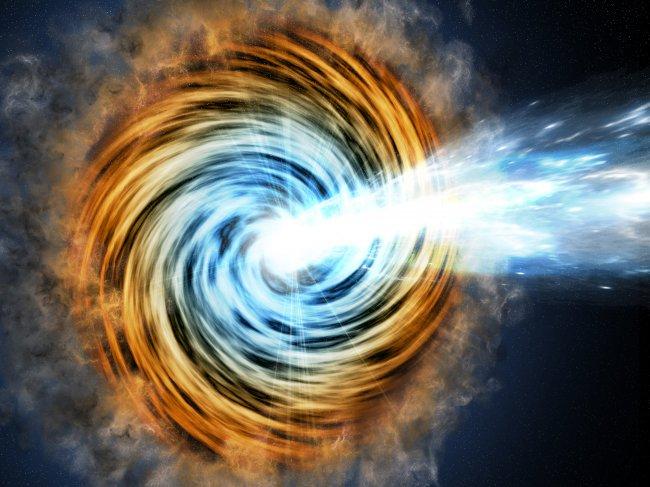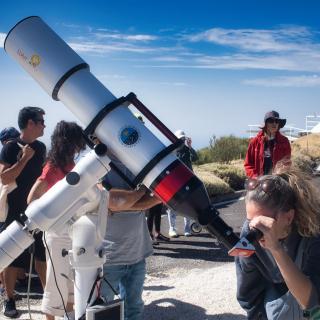An international team of researchers reports the first detection of very high-energy gamma-ray emission from the distant active galaxy PKS 1441+25. The discovery was made by the MAGIC (Major Atmospheric Gamma-ray Imaging Cherenkov) twin telescopes, at the Observatorio Roque de los Muchachos (ORM), located on the Canary island of La Palma (Spain).
The MAGIC collaboration pointed the telescopes to this object following a flare seen at lower energies by the Fermi satellite. The detection was afterwards confirmed by the VERITAS (Very Energetic Radiation Imaging Telescope Array System) telescopes, located in Arizona (USA). The results will appear in a paper to be published in the Astrophysical Journal Letters.
Marina Manganaro, postdoc at the Institute of Astrophysics of Canary islands (IAC) explains: "Analyzing data from such a distant galaxy was very exciting and felt like travelling back in time to learn more about our Universe's history”.
The Instituto de Astrofísica de Canarias (IAC), the Universidad Complutense de Madrid (UCM) and the Institut de Física d’Altes Energies (IFAE) have participated in this research.
High energies
The gamma rays are radiation with the highest energy and PKS 1441+25 is one of the two most distant active galaxies detected up to such extreme energies (the other one is QSO B0218+357, another source recently detected by MAGIC). The very high-energy emission interacts on its way to Earth with the diffuse light filling the Universe, the extragalactic background light. This diffuse light retains the history of the evolution of the stars and galaxies. PKS 1441+25 is halfway in time between the origin of the Universe and us. That is why it can be used as a lighthouse to derive information on the evolution of the Universe from half its age up to the present day. In other words, its radiation has been travelling for the second half of the lifetime of the Universe until it reached the MAGIC telescopes.
Abelardo Moralejo, researcher at IFAE, explains: "These observations have allowed us to verify, for the first time at such a large scale, that the absorption of very high energy photons in the intergalactic medium is consistent with what we know of their fundamental interactions, and with the current estimates of the density of diffuse light in the Universe."
Besides its distance, PKS 1441+25 is one of the very few Flat Spectrum Radio Quasars (a family of extremely luminous galaxies carrying hot, high-velocity gas, deep in the gravitational well of their central black hole and shooting plasma jets in our direction at a velocity close to that of light) detected at such extreme gamma-ray energies, allowing us to study its intrinsic characteristics. Flat Spectrum Radio Quasars are puzzling sources and scientists struggle to explain the emission of very high-energy gamma rays from them, observations such as those performed by MAGIC give crucial inside into those sources.
Some of the galaxies are called active, as they produce in their central parts much more light that can be explained by the stellar and dust emission. Active galaxies, hosting at their centres a supermassive black hole with a mass of million up to few billion times the mass of the Sun are amongst the most powerful objects in the Universe and dominate the gamma-ray sky: they are able to accelerate charged particles up to very high energies. A quasar is an active galaxy seen from a specific perspective. All quasars are active galaxies but not all active galaxies are quasars.
The extreme Universe
Gamma rays depict the extreme Universe, but such highly energetic emission suffers absorption in its journey to Earth due to the interaction with diffuse emission, the extragalactic background light. The extragalactic background light acts as a sort of ‘haze’ which dims the gamma-ray brightness of distant galaxies. As Miguel Nievas Rosillo, a PhD student at the Universidad Complutense de Madrid explains: "The absorption of gamma-rays during their travel from distant galaxies towards us makes their study very challenging”. And he points out: “Nevertheless with MAGIC we were able to collect high quality data from a very distant source, confirming the good performance of the instrument.”
At the same time, this extragalactic background light generated by stars and dust throughout the history of the Universe traces the evolution of the Universe after the appearance of the first stars. In this context, powerful active galaxies, such as PKS 1441+25, can be used as distant lighthouses to infer the characteristics of the extragalactic background light between the Earth and the position of the active galaxy, and, hence, to infer important details of the story of the evolution of the Universe.
As has been mentioned, PKS1441+25 and QSO B0218+357 are the oldest (or farthest) very high-energy gamma rays ever detected from ground observatories. Razmik Mirzoyan, spokeperson of the MAGIC Collaboration, tells us that "hunting very distant sources allows gamma-ray astrophysicists to find the limits of the observational universe”. And reveals that “the universe is only partially transparent to very high-energy gamma rays, measured by MAGIC".
In the paper recently accepted for publication in the Astrophysical Journal Letters, the current models of the extragalactic background light which constrain the evolution of the Universe from its middle age until today were tested for the first time up to energies never reached before for such distant galaxies.
MAGIC
The MAGIC (Major Atmospheric Gamma-ray Imaging Cherenkov) experiment is located in the Observatorio del Roque de los Muchachos (ORM), at 2200 meters above sea level on the Canary island of La Palma. The system of two MAGIC telescopes, each of 17 metres in diameter, is currently measuring very high-energy gamma rays from cosmic sources in the energy range between 25 GeV and 50 TeV. The gamma rays penetrate into Earth’s atmosphere and produce avalanches of secondary particles that emit Cherenkov light. MAGIC is studying gamma rays from galactic and extragalactic sources by recording and analyzing stereoscopic pictures of these Cherenkov flashes. MAGIC has been built with the joint efforts of a largely European collaboration that includes about 160 researchers from Germany, Spain, Italy, Switzerland, Poland, Finland, Bulgaria, Croatia, India and Japan.
More information
NASA's Fermi Satellite Kicks Off a Blazar-detecting Bonanza (press release)
NASA/Blazar Bonanza (video)
MAGIC website



